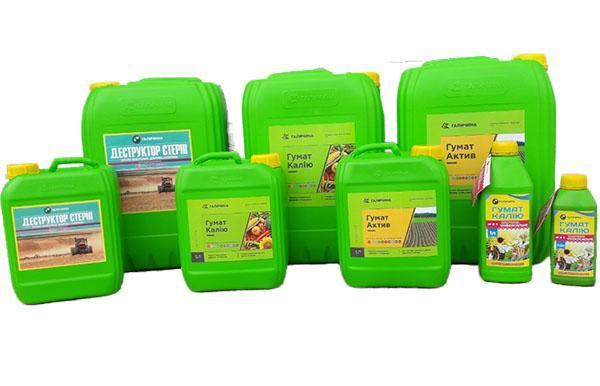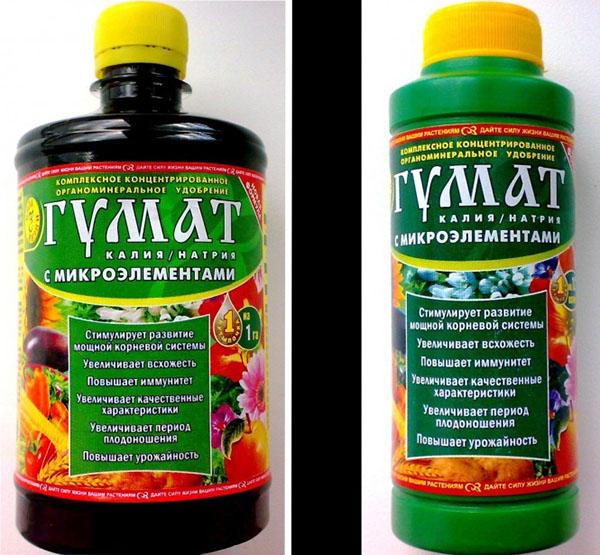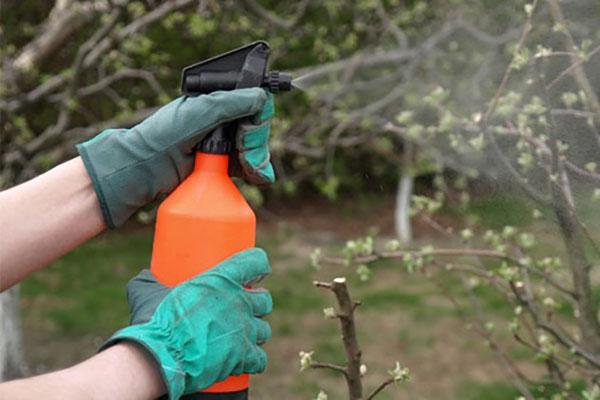Potassium humate liquid - application, benefits, dosages for different types of plants
 Liquid potassium humate, the use of which is useful for all types of plants, is easy to use at home. This fertilizer is suitable for horticultural crops, ornamental and potted plants. It can be added to water for irrigation and can also be sprayed on green parts of plants. Potassium humate improves the properties of the soil, thereby positively affects the growth and fruiting rates of crops, stimulates the flowering of indoor plants. It is sold in powder form, but there is also a liquid concentrate that is easy to use.
Liquid potassium humate, the use of which is useful for all types of plants, is easy to use at home. This fertilizer is suitable for horticultural crops, ornamental and potted plants. It can be added to water for irrigation and can also be sprayed on green parts of plants. Potassium humate improves the properties of the soil, thereby positively affects the growth and fruiting rates of crops, stimulates the flowering of indoor plants. It is sold in powder form, but there is also a liquid concentrate that is easy to use.
The composition and mechanism of action of the fertilizer

Potassium humate is a fertilizer that consists of 80% humic acids. In addition, there are proteins and amino acids, enzymes and growth promoters, natural antibiotics. Fertilizer reduces soil acidity, activates the activity of beneficial soil microorganisms and stimulates the development of cultivated plants. It is recommended to use it for soils with a neutral or acidic reaction, and in alkaline soils and fertile chernozems, the substance will not show the required effectiveness.
There are several types of potassium humate on sale:
- powder - used after preliminary dilution with water;
- liquid form - it is a concentrate, which must also be diluted before use;
- potassium humate "Prompter" - the use of fertilizer is useful for frequent application, and it is obtained from sapropel (sediments at the bottom of fresh water bodies).
Liquid potassium humate is an active concentrate of dark brown color. It is extracted from peat, and diluted in a large amount of water before use.
Results after applying potassium humate
 The use of liquid potassium humate is useful for all types of plants. It has a complex effect on the root system and aboveground parts, stimulates growth and increases productivity.
The use of liquid potassium humate is useful for all types of plants. It has a complex effect on the root system and aboveground parts, stimulates growth and increases productivity.
Its introduction into the soil causes the following positive effects:
- quick restoration of soil properties, even depleted by heavy crops;
- acceleration of the formation and ripening of fruits (some crops begin to bear fruit 1-2 weeks earlier);
- improving the characteristics of the crop, including its ability to long-term storage;
- increasing the immune defense of plants, their resistance to unfavorable environmental factors, temperature extremes;
- improved seed germination and seedling survival in open ground;
- stimulation of flowering of decorative crops.
Potassium humate is easy to use. Moreover, fertilization is considered to be very economical. 1 g of dry powder is equivalent to 1 ton of organic additives (manure or humus), which significantly saves space for storing dressings. Another advantage of humates is that they belong to environmentally friendly fertilizers. They do not accumulate in soil and plant parts, especially in fruits. Even exceeding the dosage does not affect the quality of the yield and will not cause poisoning with the fruits.
Potassium humate liquid - application for different types of plants
 The instructions for the use of potassium humate indicate dosages, a method of dilution and features of use for different types of crops. The drug is sold both in small bottles and in cans and is presented as a brown liquid. This is a concentrate, which is diluted with plain water before use - just add 0.1-0.2% of the substance.
The instructions for the use of potassium humate indicate dosages, a method of dilution and features of use for different types of crops. The drug is sold both in small bottles and in cans and is presented as a brown liquid. This is a concentrate, which is diluted with plain water before use - just add 0.1-0.2% of the substance.
Further, the working solution can be used in different ways:
- Seed soaking is a procedure that significantly improves germination rates. It is enough to soak the bulbs in a diluted solution for 8 hours, the seeds for 24 hours. Seeds of cucumbers and ornamental flowering plants can be left for 2 days.
- Spraying is the easiest way to fertilize. The substance is perfectly absorbed through the green mass of plants and is used to maintain biochemical processes. The solution is dispensed from a nebulizer using a respirator and protective suit. For potted plants, you can take a bottle with a special spray nozzle.
- Watering - this method of fertilization is used if there is a need to improve the properties of the soil. The procedure is best done in early spring, several times with an interval of 10 days. Under one plant, you can add from 500 ml to 1 l of a working solution of potassium humate.
- Soil treatment - for this method, it is better to purchase fertilizer in powder form. It is combined with ordinary sand and scattered over the surface of the soil in early spring. 10 m2 enough 50 g of the drug. The substance will be absorbed into the ground with melt water, but you can add it in the warm season, and then dig up the area.
The use of liquid potassium humate in combination with other mineral and organic fertilizers significantly increases its activity. The exception is phosphorus fertilizing - they form persistent insoluble compounds with humates, so they are introduced separately.
Dosages for different types of plants
 Potassium humate is a versatile fertilizer that is useful for different crops. For each of them, it is important to follow the feeding scheme so that the plants receive a sufficient amount of nutrients.
Potassium humate is a versatile fertilizer that is useful for different crops. For each of them, it is important to follow the feeding scheme so that the plants receive a sufficient amount of nutrients.
Experienced gardeners recommend sticking to the following schedule:
- carrots, zucchini, white cabbage, beets - 4 sprays per season, as well as soil treatment before planting;
- potatoes - additional soaking or spraying of tubers before planting in the ground;
- cucumbers and tomatoes - at least 3 sprays during the warm season, soaking the seeds;
- greens - watering in the amount of 3-10 liters per meter of planting;
- fruit and berry plants - it is important to apply fertilizers in early spring, as well as during flowering and fruit setting;
- indoor plants - 1 spraying every 2 weeks during the warm season, 1 treatment per month in winter.
Liquid Potassium Humate is a beneficial additive that improves crop endurance and yield. It can also be used for ornamental plants, since no humus is produced in pots. The instructions for use indicate how to breed potassium humate for indoor flowers, vegetables and fruit crops, garden plants and greenery. The product is stored in a concentrated form, therefore, for processing large areas, it will be needed in a minimum amount.